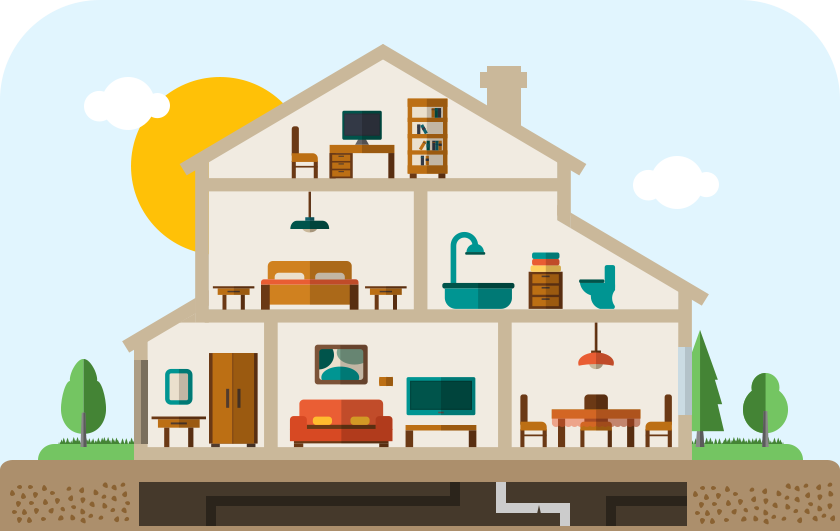When it comes to home energy, the mantra “use less, save more” holds true no matter where one lives, who provides the energy, or whether current energy costs are going up or going down. There are many actions homeowners can take to make their homes more energy efficient and decrease their monthly utility bills. A great place to start is with a home energy audit, which assesses where and how much energy a home consumes; then it’s on to correcting whatever inefficiencies are found. Find tips on maximizing your energy-efficiency to keep costs – and your carbon footprint – down.
More than $13 billion worth of energy leaks from houses through small holes and cracks every year – more than $150 per family.
Source: epa.gov
10 Tips To Find (and Fix) Energy Waste
Want to save on your home energy bills and make a positive contribution to the environment at the same time? The first step is a home energy audit. Usually, home energy audits are performed by professionals who are trained to conduct room-to-room examinations to find energy waste. Professionals are great for identifying even the smallest issues. However, homeowners with a little savvy and experience should be able to catch a lot of problems themselves with their own do-it-yourself home energy audits. Check out the graphic below to find out about some of the most common home energy inefficiencies, and how to fix them:


Replace furnace filters to improve efficiency of your home’s heating and cooling systems. Replacing a furnace filter every four to six weeks is a good rule of thumb.
Lack of insulation can cause substantial heating and cooling losses. Adding insulation is one of the best ways to increase energy efficiency and make a home comfortable year-round.
Energy-saving appliances can make a big difference in home energy consumption and bills.
Add weatherstripping around doors and caulking around windows to stop air leaks from robbing a home of precious heat during the winter and cooling during the summer.
Programmable thermostats make it easy for homeowners to save money by automatically resetting temperature levels when everyone is asleep or away.
Poorly sealed, loosely connected and uninsulated ductwork is another major cause of heating and cooling loss. Sealing and insulating ducts can reduce that loss and save money.
Proper landscaping, such as strategic placement of deciduous trees on the south and west sides of a home, provides energy-saving shade in the summer, while allowing warming sun to shine through in the winter.
Older, single-pane windows can mean serious heat (and wallet) drainage. Replace them with newer energy-efficient frames and glass, or repair and insulate older ones.
Taking a shower uses 2.5 gallons a minute when using a standard showerhead. Installing low-flow showerheads will save on water and the energy it takes to heat that water.
Switching out old light bulbs with energy-efficient halogen incandescents, compact fluorescent lamps or light-emitting diodes can mean significant energy savings over time.
Post-Audit Fixes for Common Issues
The fact is that air is a very poor conductor of heat, and that includes the heat you want to keep inside your home (during the winter) and the heat you want to get rid of (during the summer). Homeowners can save an average of 11 percent on total energy costs simply by air sealing their homes and adding insulation in attics, floors over crawl spaces, and accessible basement rim joists. How do you know if you need new or more insulation? Check for cold spots or drafty walls. And if your furnace is running non-stop in the winter, and your air conditioner is running constantly in the summer, it’s time to think insulation.
Approximately 20 to 30 percent of the air moving through the duct system in the typical home is lost due to leaks, holes, and poorly connected ducts. That’s a big loss of energy and money. Signs of duct problems include stuffy, uncomfortable rooms; ducts located in the attic, crawlspaces and/or the garage; and, of course, high utility bills. Hiring a professional to fix ducts is recommended. Do-it-yourself homeowners should start by sealing air leaks with metal tape (not duct tape) or mastic sealant. Then insulate ductwork where there is access.
Programmable thermostats allow homeowners to set the temperature in their homes to ideal levels for comfort and energy savings, and not have to worry about wasting energy during the day, night, and when no one is at home. In other words, it’s set-it-and-forget-it. You may or may not need a professional to install a programmable thermostat, and proper programming can be complicated, at least at first. But the benefits can be substantial. In fact, a properly set programmable thermostat could mean a savings of about $180 annually for a typical single-family home, according to the EPA’s Energy Star.
Lighting accounts for about 5 percent of energy usage in the average home, which may not sound like much at first. But consider this: a typical homeowner can save approximately $75 a year by simply replacing traditional incandescent light bulbs with newer energy-efficient ones in a home’s five most frequently used light fixtures. That’s because energy-efficient halogen incandescents, compact fluorescent lamps (CFLs), and light-emitting diodes (LEDs) normally use about 25 percent to 89 percent as much energy compared to traditional incandescents. They also last three to 25 times longer than standard light bulbs, according to the EPA’s Energy Star.
Windows can be one of the most practical and attractive features of any home. They can also be a real friend or real foe when it comes to energy consumption. If you have older window frames holding single-pane glass, for example, you are likely experiencing major heat losses, accounting for 25 to 30 percent of a home’s heating bills. Replacing old windows with new, efficient Energy Star-rated ones can be costly upfront but mean substantial savings in the long run. Be sure to check on rebates from your local utility, too. If you’re not ready to invest in new windows, you can still make a difference by repairing or weatherizing older ones.
Showers account for a lot of water usage in the typical American home – as much as 40 gallons a day for a family of four. But taking showers doesn’t just consume a lot of water – it also consumes a lot of hot water. And heat means energy. One answer is to replace a home’s old showerheads with ones that use no more than two gallons of water per minute. Doing so could save the average family as much as 370 kWh of electricity a year, which is enough energy to power that typical American home for 13 days, according to the EPA.
A major culprit in home energy loss is the garden-variety air leak, particularly those that occur around exterior doors. Check around the door, especially at the bottom. If you can see daylight coming in from underneath, it’s time to install a new threshold or weatherstripping. There are many types of weatherstripping available and it’s important to use the type associated with the specific door’s location (interior or exterior, area climate, etc.). Also, use the proper caulk for air leaks around windows. Sealing air leaks along with installing proper insulation can save up to 10 percent on a home’s annual energy bill, according to the EPA’s Energy Star.
Here’s an easy tip to remember: a clean furnace is a more efficient furnace. In this case, a clean furnace means one putting out cleaner, more breathable air. The key to maintaining a clean, energy-efficient furnace or HVAC system is to change its filter on a regular basis. Filters, particularly the newer, higher-efficiency pleated filters with built-in electrostatic charge, can quickly become clogged with dirt, mold spores and other particles. And when the filter is dirty, the system has to work harder. The solution is to replace the filter as recommended or, at a very minimum, every three months.
Appliances are a big user of energy, accounting for approximately 13 percent of the average home’s total energy costs, according to the Department of Energy. That number includes the costs to run water heaters, refrigerators, laundry and dishwashers, stoves, ovens and more. It also includes smaller items like microwaves, toaster ovens, hair driers, televisions, and others that you might not normally give a second thought to. Fortunately, manufacturers have stepped up to the challenge by creating more energy efficient products. When purchasing new appliances, consider both the purchase price and the estimated yearly energy operating cost, which is typically indicated on a U.S. Government Energyguide sticker attached to appliance.
Landscaping done right can have a significant positive impact in all sorts of ways like conserving water, providing windbreaks, reducing noise and air pollution, and lowering yard maintenance costs. Proper landscaping can also mean a cooler environment and significant reduction in home energy consumption. The key is to landscape for shade. The right placement of shade trees throughout a neighborhood can reduce summer air temperatures by as much as 6 degrees compared with treeless areas. Also, proper landscaping can reduce an unshaded home’s air conditioning costs by up to 50 percent.
50 Inexpensive Ways to Green Your Home
Kitchen
Use microwave and toaster ovens instead of your full oven. They use less energy and don’t overheat your kitchen.

Cook multiple meals at the same time when using your oven. Reheating takes less heat than cooking.
Turn off oven fans as soon as you’re done cooking and bathroom fans as soon as you’ve finished your bathroom business.

Keep your fridge and freezer comfortably full. Refrigerators work harder to keep empty spaces cold, so fill them up and save energy.

Full, but not overloaded. Refrigerators and freezers need a little empty space to allow for proper air circulation.
Check the door seals on your fridge. If you detect cold air leaking out, have the seal repaired or replaced.
Do you really need that second fridge or freezer in the garage?
Use your dishwasher. You’ll actually use less water and consume less energy than doing your dishes in the sink.

Only run your dishwasher when it’s full. And choose the air-dry setting for additional energy savings.
Do more outdoor grilling. Cooking indoors during the summer heats up the house causing the AC to work harder.
Laundry Room
Choose a washer and dryer that meet your capacity requirements and no more. If you don’t need the jumbo-sized washing machine, get the smaller model.

Wash and dry full loads of clothes only. And if you must run a smaller load, set the water level accordingly.
Wash your clothes in cold water as a rule. Use hot only for your dirtiest loads.
Clothes washers and refrigerators today typically use half the energy of those from the early 1990s.
Source: energystar.gov
Do multiple loads of wash, one after the other. That way, you take advantage of a dryer still warm from earlier loads.

Do not overdry your clothes. Check them occasionally and pull them out as soon as they are dry. Better yet, take them out while they’re still damp and hang them up to finish drying. It will save you money on energy costs and your clothes will last longer. Or best of all, use a clothesline.
Make sure your dryer is properly vented to outside. Otherwise, you’ll be overworking your AC.
Clean the lint filter on your dryer every time you use it. You’ll use less energy and your clothes will dry faster.
Turn down the temp on the water heater. 120 degrees is plenty hot.
Heating
During the winter, set your thermostat to 68 degrees or lower. Each degree you drop will save around 3 percent on heating costs for the typical household.
The more the merrier. People bring their body heat with them, so turn down your thermostat a couple of degrees when you have guests and put that extra body heat to work.
Layer up and turn the heat down. Put on a sweatshirt or sweater, socks and slippers. Lay an extra blanket on the bed.
Layer up (the floor) and turn the heat down. Put area rugs on hardwood or tile floors to keep your feet warm.
Do not close vents in empty or unused rooms. Your thermostat and furnace don’t know they’re closed, and the unheated rooms will likely leak their cold into the rest of the house, requiring more work from your heating system.
Clean your ducts and vents regularly, and keep curtains and furniture away from vents and returns.
One more thing about curtains: use them. Close them at night to help keep the heat in. Open them during the day to let the sun in and help warm the house.
Use spot heaters judiciously. Portable heaters can be useful every once-in-a-while, but they consume tons of energy and suck money from your wallet. They can be dangerous, too.
In regard to electric baseboard heaters, make sure they’re installed at the proper height and keep furniture, draperies and other items away.

Cooling
Make the most of your ceiling fan. Set it to turn counter-clockwise during the summer to pull the heat up and away, and clockwise during the winter to help push the heat down to warm people and pets.
Keep the house sealed tight when running the AC. That means keeping exterior doors and windows shut and bath and kitchen fans off.
As for interior doors, keep them open to let the AC-cooled airflow through the house more easily.
Set your AC fan to “on” instead of “auto”. A continuously running fan will keep the cooling evenly distributed even when the compressor is in its “off” cycle.
Keep your AC maintained properly. You might want to spring for a professional tune-up. And check with your utility to see if you can get a rebate to help pay for it.
Another AC tip: Don’t forget the outside compressor. Keep it clean by rinsing its exterior off with a garden hose (after shutting off the power at the breaker). Also, mind the airflow by keeping plants away by at least a foot.
When purchasing a window AC unit, get the right capacity for your room size. A unit rated for a bigger space will cycle on and off more often and consume more energy than necessary.
Apply reflective film to your windows. It will keep heat out during the summer and help prevent fading to curtains, carpets, and furniture.
Decorate with light colors. Use light-colored curtains that let some light in but keep out the heat from the sun during the day.
Add glass doors to your fireplace and close the flue when not in use. Both actions will help keep the cold air out.
Speaking of fireplaces, don’t forget to turn down your thermostat when enjoying a fire.
And be sure to have your chimney inspected and cleaned on a regular basis.
OK, one more. Only burn hardwoods that are fully dried in your fireplace. They produce more heat than other types of wood.
Lighting
Know the numbers. For example, choose compact florescent light bulbs with a wattage rating of about one-third of what you would get with a standard incandescent bulb.

Try using only one bulb in a multi-bulb fixture. You can often use a higher wattage for the single bulb, but be sure to check the maximum wattage for bulbs in the specific fixture first.
Keep floor or table lamps away from your thermostat. They can wreak havoc on your thermostat settings.

Dust your light fixtures regularly. Dust can block up to half of a bulb’s output.
Use dimmers, motion sensors, timers, photocells and other lighting control devices whenever feasible. They’ll help to minimize actual lighting time.
Computers and Electronics
46Turn off and unplug computers and other electronic devices when not in use. Use power strips to make switching on and off easier.
47Use laptop computers instead of desktop models. They use less energy. Use inkjet printers instead of laser printers. Same reason.
Miscellaneous
Protect your insulation from getting wet. Fix leaks in your roof and waterproof your basement.

Insulate behind electrical outlets and switch plates with foam gaskets. And use those little plastic safety plugs on unused outlets.
Plant shrubs and bushes along exterior walls to help insulate them during the summer. Remember to leave about a foot of space between the wall and the plants.
Sources: Ameren Illinois; Duke Energy; PowerHouse/Alliant Energy
The typical U.S. family spends at least $2,200 a year on home utility bills.
Source: energy.gov
Spotlight: Ecobroker Andy Cochran

It is basically a course realtors can take regarding sustainability that provides tools to not only work with clients but also with mortgage brokers and others.
It really depends on the house. It’s often about insulation. For example, in an area that has a lot of older homes, built in the 1800s on stone foundations, I will suggest getting foam insulation and foaming the exterior walls. And not just in the walls, but also in the ceiling. Also, windows are always an issue in older homes. When I show listings to potential buyers, insulation and windows tend to be what they’re most concerned about.
In my case, I work a lot with Efficiency Vermont,* who will actually come out [to the home] and do a blower test, and advise homeowners on the best ways to improve their energy efficiency.
Yes. Green Mountain Power, which is one of the major utilities here, has come up with a program where they are installing Tesla batteries for energy storage to offset more expensive electrical costs. It’s just a test program right now, but we’ll see where it leads.
*A non-profit statewide energy efficiency utility that advances sustainable energy solutions through education, services, and incentives to homeowners and businesses.
Resources for Optimizing Energy Efficiency
Saving energy is a real issue for everyone: individuals, businesses, utilities, as well as state and local governments. With all this concern, it’s no surprise that there is a wealth of excellent energy-saving resources to be found online. Here’s a small sample:
- American Council for an Energy-Efficient Economy (ACEEE): The ACEEE website offers portals to information on national, state and local energy efficiency policies, residential homes and appliances, and more.
- Database of State Incentives for Renewables & Efficiency (DSIRE): DSIRE provides a comprehensive search engine for information on incentives and policies that support renewable energy and energy efficiency throughout the United States.
- Energy Efficiency Resource Center: Sponsored by the Energy Education Council, this site provides a variety of helpful resources including a library page with information on a broad cross-section of energy efficiency topics.
- Energy Savers Services (Energy.gov): Brought to you by the U.S. Department of Energy, this page provides links to an excellent energy saver guide and do-it-yourself savings projects.
- Energy Star: Energy Star is an Environmental Protection Agency program designed to help businesses and individuals save money and protect the environment through energy efficiency. The website offers a clearinghouse of information and tips on saving energy for homeowners.
- EPA State and Local Climate and Energy Program – Residential Energy Efficiency Page: Another great site for information regarding local and state energy-savings initiatives and programs.
- Habitat for Humanity – Energy Efficiency: This site offers a wealth of information in the form of basic “how-to” guides for creating more energy-efficient homes and links to other useful resources.
- Home Energy Saver: A joint project of several government agencies and non-government organizations, the Home Energy Saver website offers tips for home energy savings and recommendations for energy-saving upgrades.
- Residential Energy Services Network (RESNET): RESNET, a non-profit organization, helps homeowners reduce the cost of their utility bills by making their homes more energy-efficient.
- Smarter House: A project of the ACEEE, the Smarter House website provides information on saving energy in the home, planning energy improvements and much more.



